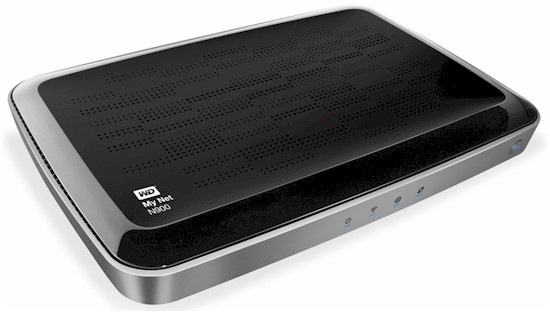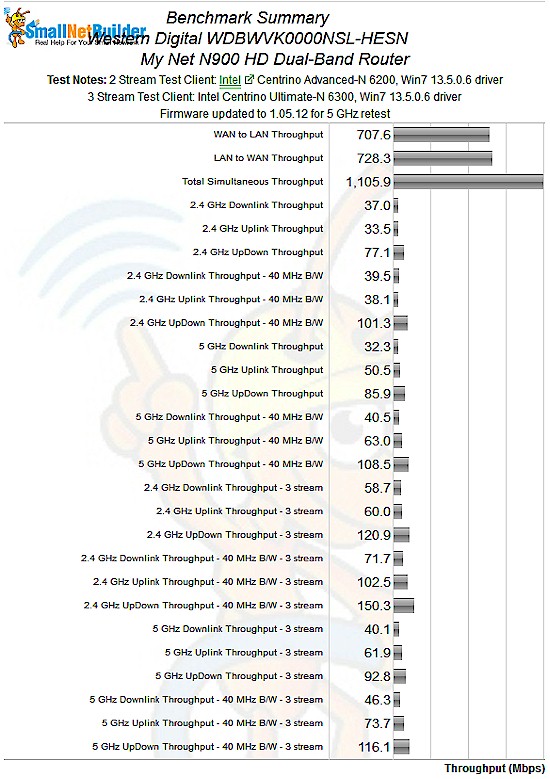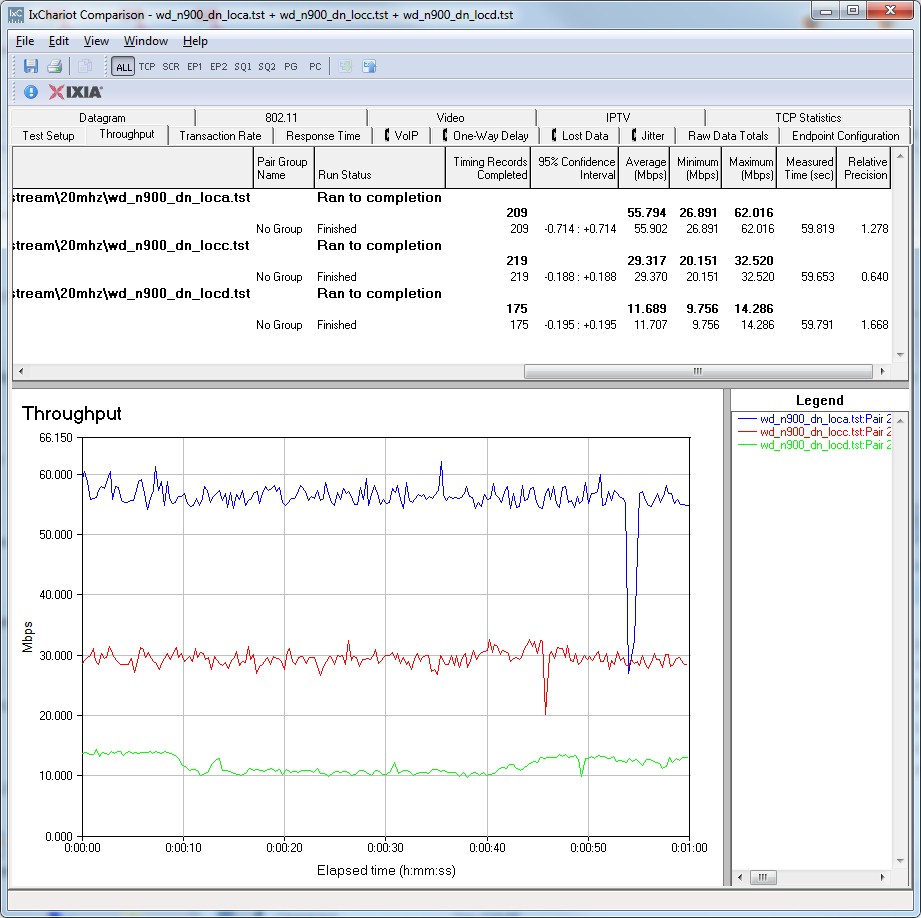
| At a glance | |
|---|---|
| Product | Western Digital My Net N900 HD Dual-Band Router (WDBWVK0000NSL-HESN) [Website] |
| Summary | Ubicom-based “N900” router with Atheros radios, seven Gigabit LAN ports, USB printer and file sharing. |
| Pros | – High routing throughput – Produced the highest wireless throughput seen yet – 20+ MB/s NTFS filecopy write/read |
| Cons | – Better wireless throughput uplink vs. down |
Typical Price: $69 Buy From Amazon
Overview
In our original My Net N900 review, I found a manufacturing problem in my review sample that caused very poor 5 GHz performance. WD said that the problem was confined only to early product that was sent to reviewers and not to stores. But it took WD until just last week to send a new sample for retest.
I reran the 5 GHz tests only and updated the relevant Router Charts wireless benchmarks, replacing the previous data. The summary and analysis with the new 5 GHz data follows. The short story is that the router is capable of very high uplink throughput in 5 GHz, but downlink performance isn’t as strong, especially as signal levels drop.
Wireless Performance Overview
The retest Benchmark Summary is shown below. The overall average difference between two and three stream operation still isn’t that striking because three-stream N can only provide significantly higher throughput under very strong signal conditions (same room or next-room).

N900 benchmark summary
So that you don’t have to flip back and forth between the Benchmark summary in the original review, I’ve compiled the two sets of results into Table 1 and calculated the difference between them.![]() It’s obvious that the two-stream average results are all better and the three-stream all worse.
It’s obvious that the two-stream average results are all better and the three-stream all worse.
| Test Group | Retest | Original | % Difference |
|---|---|---|---|
| 2 stream 20 MHz Dn | 32.3 | 25.9 | +25 |
| 2 stream 20 MHz Up | 50.5 | 35.6 | +42 |
| 2 stream 20 MHz Up/Dn | 85.9 | 62 | +39 |
| 2 stream 40 MHz Dn | 40.5 | 35.8 | +13 |
| 2 stream 40 MHz Up | 63 | 40.2 | +57 |
| 2 stream 40 MHz Up/Dn | 108.5 | 86.2 | +26 |
| 3 stream 20 MHz Dn | 40.1 | 55.7 | -28 |
| 3 stream 20 MHz Up | 61.9 | 81.4 | -24 |
| 3 stream 20 MHz Up/Dn | 92.8 | 100.1 | -7 |
| 3 stream 40 MHz Dn | 46.3 | 65.3 | -29 |
| 3 stream 40 MHz Up | 73.7 | 126.3 | -42 |
| 3 stream 40 MHz Up/Dn | 116.1 | 120.5 | -4 |
Table 1: Retest and Original 5 GHz Benchmark Summary results
Table 2 summarizes the highest wireless throughput measured out of all locations in the original test runs.![]()
| Test Group | Max Dn (Mbps) | Max Up (Mbps) | Dn/Up (Mbps) |
|---|---|---|---|
| 5 GHz, 2 stream, 20 MHz | 41 | 51 | 62 |
| 5 GHz, 3 stream, 20 MHz | 78 | 93 | 100 |
| 5 GHz, 2 stream, 40 MHz | 58 | 70 | 86 |
| 5 GHz, 3 stream, 40 MHz | 98 | 167 | 120 |
Table 2: Highest 5 GHz Throughput, original test
Table 3 summarizes the highest wireless throughput measured out of all locations in the retest.![]()
| Test Group | Max Dn (Mbps) | Max Up (Mbps) | Dn/Up (Mbps) |
|---|---|---|---|
| 5 GHz, 2 stream, 20 MHz | 56 | 90 | 86 |
| 5 GHz, 3 stream, 20 MHz | 58 | 103 | 93 |
| 5 GHz, 2 stream, 40 MHz | 66 | 128 | 108 |
| 5 GHz, 3 stream, 40 MHz | 61 | 139 | 116 |
Table 3: Highest 5 GHz Throughput, retest
Comparing Tables 2 and 3 shows the same pattern as Table 1, i.e. performance improved for two-stream, but decreased for three-stream, with only a few exceptions.
The overall good news, however, is that I was able to run tests in Location A, C and D in all modes and with both the two and three stream test clients. And I didn’t have any of the random disconnects I experienced with the original test sample.
Wireless Performance – 5 GHz, Two Stream
For performance comparison, I chose the same set of routers as in the original review: the ASUS RT-N66U "Dark Knight"; Cisco Linksys E4200V2; and NETGEAR R6300. Here is the Performance Table for 5 GHz, 2 streams
As noted earlier, I was able to take measurements in Location D for all test runs. None of the selected routers won in all four benchmarks, although the ASUS was the strongest performer running downlink in both 20 and 40 MHz bandwidth modes.
On the other hand, the WD turned in the highest throughput measurement of 128 Mbps in Location A running uplink in 40 MHz mode. To balance out that positive, note that the WD tended to have the lowest Location D (weakest signal) throughput.![]()
The IxChariot plot below for 20 MHz mode downlink shows generally stable throughput.

WD N900 IxChariot plot summary – 5 GHz, 20 MHz mode, downlink, 2 stream
This is also the case in most of the other plots linked below, albeit with higher variation shown in the 40 MHz mode plots.
- 5 GHz / 20 MHz uplink
- 5 GHz / 20 MHz up and downlink
- 5 GHz / 40 MHz downlink
- 5 GHz / 40 MHz uplink
- 5 GHz / 40 MHz up and downlink
Wireless Performance – 5 GHz, Three Stream
Here is the Performance Table for 5 GHz, 3 streams. The ASUS is the overall winner in this comparison, taking three out of four benchmarks. But, once again, the WD shows its strength with strong-signal uplink performance, coming within 5% of the ASUS in both 20 and 40 MHz modes in Location A with 103 and 136 Mbps, respectively.
The IxChariot plot below for 20 MHz mode downlink once again shows generally stable throughput for the stronger-signal location A and C runs. But with the lower signal in Location D, throughput starts to bounce around more.

WD N900 IxChariot plot summary – 5 GHz, 20 MHz mode, downlink, 3 stream
You’ll see the higher variation even in stronger signal runs in some of the plots linked below.
- 5 GHz / 20 MHz uplink
- 5 GHz / 20 MHz up and downlink
- 5 GHz / 40 MHz downlink
- 5 GHz / 40 MHz uplink
- 5 GHz / 40 MHz up and downlink
Closing Thoughts
The My Net N900 is not a bad first router effort from WD, with 20 MB/s + storage filecopy performance, decent feature set including free parental controls/web filtering for up to 15 devices, 700+ Mbps wired routing speeds and Ubicom-based automatic Qos.
Our initial review showed it also has some of the highest throughput I’ve ever seen from a three-stream "N900" router on its 2.4 GHz side. And with the properly-operating new sample, I can say the same for the 5 GHz side. But those high speeds are only running uplink and only with a very strong signal (same room or maybe next room).
When it comes to downlink performance or as signal levels drop, the My Net N900 looks less attractive than other choices in top-end "N900" routers.
